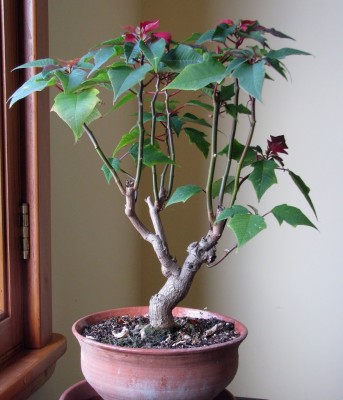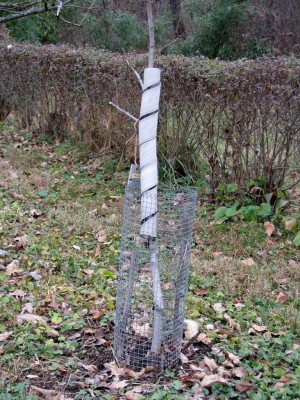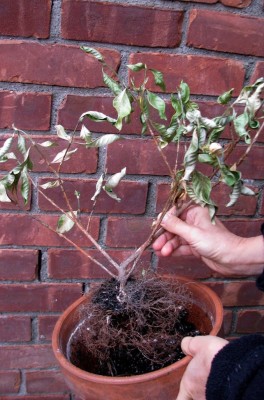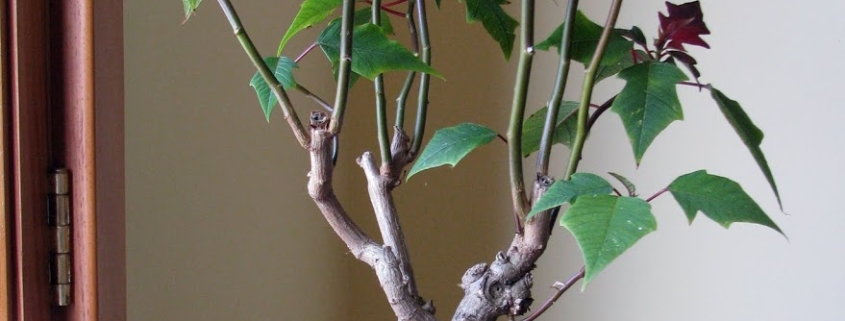[poinsettia, winterize trees, dead gardenia]
Time for the next step in hunkering down for winter – not by caulking around windows, not by propping snow shovels next to the front door, not by waxing up the skiis. What winter will need is flowers. Or, at least, I need flowers to make winter more pleasant.

Poinsettias and jasmines are the flowers du jour. Not that either is blooming yet. As I said, it’s time for the “next step” in preparing for winter. Both these plants would naturally bloom sometime in spring but I need them blooming in the depths of winter.
I began planning for both plants’ winter bloom back in September’s balmy days. Not much was required. All the plants needed were nights of uninterrupted darkness and cool temperatures. And, for the jasmine, also being kept on the verge of thirst.
With more than enough neglect behind them, these plants should be ready to bloom. The poinsettia came up from the cool basement window where it resided since October, and the jasmine came in from the cool greenhouse, where it resided since early November. Both plants are now sitting in warm rooms basking in the sun of south-facing windows, and will hopefully blossom within a few weeks.
I could have – should have – brought the plants to those warm, sunny windows a few weeks ago. Then, they might have been in bloom for the holidays. November sped by too quickly.
*************************************
Winter preparations are also going on outdoors. I’m winterizing – not my car, but my trees. First comes a 2 to 3 inch layer of wood chips beneath the plants. Rather than the conventional, tight landscape ring around the base of the tree, which does little more than keep mowers at bay, my young trees get mulched out at least as far as the spread of their branches. Older trees’ roots fend for themselves in mowed ground without mulch.
Next comes protection from rodents. Mice revel in that soft layer of mulch around trees so I keep it back a few inches from trunks. Then, mice may have lodging but at least no ready food. To further keep them and rabbits at bay, each young tree gets a 2-foot tall cylinder of quarter- or half-inch mesh hardware cloth at its base.

The hardware cloth cylinder is thoroughly effective until a foot or two of snow accumulates, at which time the rabbits perch on top of the snow and casually munch on small trunks and branches. To thwart such bad behavior (from my perspective), above the cylinders I swaddle trunks and main branches with plastic spirals (sold for protecting trunks).
And then there’s winter cold. Actually, cold and warmth, which together is what drive trees crazy. Imagine a bright, cold, winter day: The sun shines on dark tree bark, warms it, then, abandoning the tree, drops below the horizon. Temperature of that warmed bark immediately plummets, to the tree’s dismay. To prevent see-sawing temperatures, I either paint trunks white with latex paint diluted half with water, or wrap trunks with white Dewitt Tee-Wrap, which also protects trunks from borers.
*********************************
Back indoors, one plant that won’t be brightening winter with its blossoms will be my gardenia. The foliage has collapsed, dried and shriveled. Yellowing of a few leaves a few weeks ago made me suspect that the plant was hungry for some nitrogen. Perhaps a more acidic soil was needed, or iron. Not. Not. Not.

I finally gave up the ghost on the plant, tipped it out of its pot, and performed an autopsy. The roots looked surprisingly healthy. Not so, the stems. Slices into it at various points revealed grayish brown flesh indicating the plant was thoroughly dead at least down to its roots.
Despite the healthy appearance of the roots, I suspect that the problem was too much water. (Or too much fertilizer?) Especially in cool weather, gardenias get sick and often die from excessive water.
Gardenias are amongst the most challenging of houseplants to grow. Yet I remember a beautiful, large gardenia plant basking in a sunny window in the house of my friend Mike’s mother, who otherwise had no particular interest or skill with plants. I’m not giving up. I’m getting a new plant.
********************************************




Gardenias like to be watered from the bottom.
Thanks. I am definitely going to give gardenia yet another try.
Do you have any advice for avoiding damage by voles? Last year a perennial bed was eaten by voles (including plant roots). We have no pets in the garden. Thanks
Best for vole control are cats, outdoor cats. Even if they don’t go in the garden, they patrol it. Traps baited with peanuts work well; use live traps if other pets my get caught in the traps. Close mowing in fall also helps by giving the critters less places to hide from their predators.